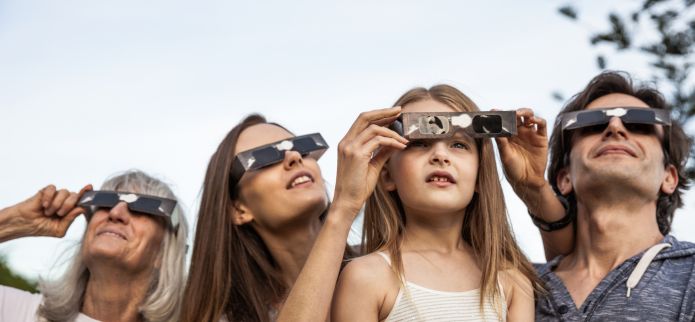Countdown to the 2023 Annular Solar Eclipse!

Rare ‘Ring of Fire’ Eclipse Can Be Viewed from Oregon’s Adventure Coast October 14, 2023
If you’re planning to visit Oregon’s Adventure Coast: Coos Bay, North Bend, Charleston the 2nd weekend in October, you’re in for a special treat! If you haven’t heard, parts of the Western United States will experience an annular solar eclipse this fall (a.k.a. “Ring of Fire” event)! Sky-watchers from all over the region can experience the big show on Oregon’s Adventure Coast at 9:18 a.m. Pacific Standard Time on Saturday, October 14, 2023. In fact, we will be among the first in the U.S. to see it before it continues to move southeast towards Texas, Central America and South America.
What is it like Inside the Path of an Annular Solar Eclipse?

According to the website, Great American Eclipse , “an annular solar eclipse promises a spectacular vision featuring the striking sight of the Sun as a ring.” Those inside the path of the 2023 Annular Solar Eclipse will see the sun appear as a bright ring-shaped halo around the edges of the moon for a full 4 minutes before it continues southeast. Daylight will be noticeably dimmer, but viewers will not experience complete darkness like a total solar eclipse.
What Causes the Dramatic Ring of Fire?

An annular solar eclipse can only occur when the moon is at its furthest point from the Earth and passes between our planet and the sun. Because the moon is too far away to completely block out the sun, it creates a brilliant ring of light around it.
When and Where Can I Watch?
The 2023 annular solar eclipse will be visible along a narrow path that crosses from Oregon to Texas on October 14, 2023. The eclipse will make landfall along parts of the Central and Southern Oregon Coast (including Coos Bay, North Bend, and Charleston) shortly after 8 a.m., before reaching “annularity” at 9:18 a.m. This interactive map from the Oregon Museum of Science and Industry (OMSI) will help pinpoint locations to see the eclipse.
Oregon Dunes National Recreation Area , Horsfall Beach , Bastendorff Beach , Sunset Bay State Park , Cape Arago State Park , Shore Acres State Park ,, South Slough National Estuarine Research Reserve are just a few destinations on Oregon’s Adventure Coast where this astronomical event can be viewed. If you plan to view the eclipse close to water, learn how to keep yourself, your family and pets Wave Safe . Be aware of dangerous “sneaker waves” and never turn your back to the ocean.
How Can I View the Eclipse Safely?
You might have heard it 100 times before, but it cannot be stressed enough: Never Look Directly at the Sun****. Even if you wear sunglasses, looking directly at the sun without a protective filter could cause serious damage to your eyes, including blindness. “During a partial or annular (ring) solar eclipse, such as the one on October 14, 2023, there is no time when it is safe to look directly at the Sun without using a special-purpose solar filter that complies with the transmittance requirements of the ISO 12312-2 international standard ”, says the American Astronomical Society in its recommendations on how to view a solar eclipse safely.
The only safe option to view the eclipse is with an approved solar filter that blocks dangerous ultraviolet and infrared radiation, like eclipse glasses
or solar binoculars
.
Get your Eclipse Glasses at the Coos Bay Visitor Center while supplies last!
We said it earlier in this post, but it’s worth repeating to keep yourself “Wave Safe ” and never turn your back to the ocean!
If you are planning to travel to Oregon’s Adventure Coast to view the 2023 Annular Solar Eclipse on October 14, 2023, we recommend the following
-
Book your lodging as soon as possible - this astronomical event is expected to attract many visitors to our area, and hotels and campgrounds could potentially sell out.
-
Order enough eclipse glasses or solar binoculars for you and your family early. Stop in the Coos Bay Visitor Center in downtown Coos Bay to get your Eclipse Glasses while supplies last.
-
Contact the Coos Bay ~ North Bend ~ Charleston Visitor & Convention Bureau for local tips, travel ideas and other itineraries to enjoy during your visit!
Additional Resources
- https://traveloregon.com/plan-your-trip/events/how-to-experience-the-annular-solar-eclipse-in-oregon/
- https://solarsystem.nasa.gov/eclipses/2023/oct-14-annular/where-when .
- https://www.greatamericaneclipse.com/oregon-2023-eclipse
- https://www.rosecityastronomers.net/2023-eclipse
- https://eclipse.aas.org/eclipse-america-2023
- https://nationaleclipse.com/maps_2023.html
- https://eclipse2024.org/2023eclipse/eclipse_cities/states
- https://eclipse2024.org/graphics/animations
- https://www.oregonlive.com/travel/2023/01/solar-eclipse-will-bring-ring-of-fire-to-oregon-skies-this-year.html
